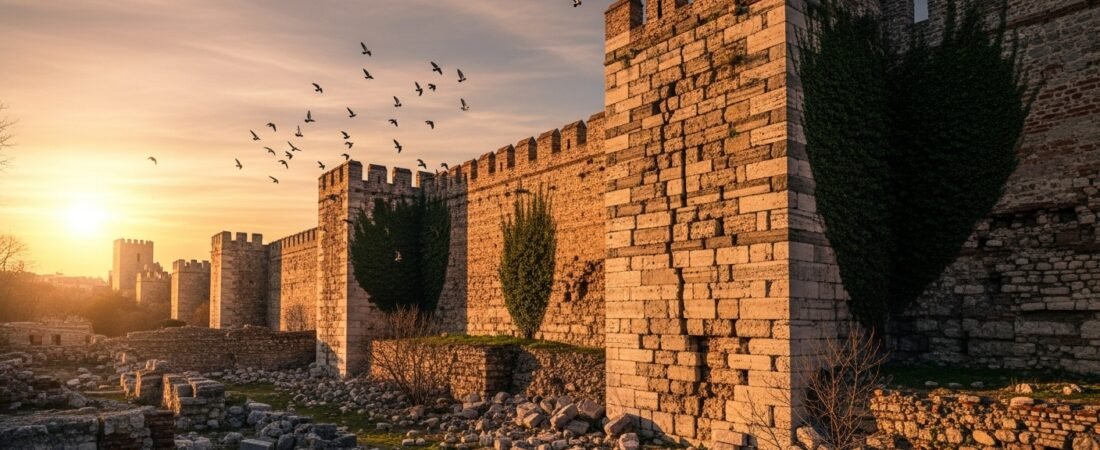Imagine a city so rich its fishermen cast bronze nets, so proud its emperors still called themselves Roman, and so blind that its own leaders sold the keys to the gates—then acted surprised when the locks no longer worked.
That city was Constantinople, the beating heart of the Byzantine Empire. For over a thousand years, it stood as a marvel of wealth, culture, and endurance. Yet when the empire finally fell in 1453, the cause wasn’t a single cannonball or a barbarian horde—it was something far more insidious: greed.
This is not just the story of a military defeat, but of an empire that sold its own future, one transaction at a time.
🏺 The Gilded Cage
By the year 1025, the Byzantine Empire was a colossus—wealthy, organized, and sophisticated. Gold flowed in from trade and taxes; Constantinople shone as the richest city in the world.
But beneath the glittering surface, corruption was spreading. High offices were no longer earned through merit but bought and sold like market goods. Emperors auctioned governorships and military commands to relatives and cronies, turning public service into private enterprise.
This created a self-destructive system: officials saw their roles not as responsibilities, but as investments to be recouped through extortion and graft. The result? A shrinking army, decaying institutions, and a bureaucracy fattened by greed. The empire’s dazzling exterior had become a gilded cage—beautiful, but hollow within.
💰 Seeds of Corruption
By the late 12th century, things had gone from bad to absurd. Under the Angelos emperors, corruption became state policy. Isaac II taxed everything from windows to gossip, while his brother Alexios III sold off entire fleets—anchors, sails, even the nails.
The navy, once the pride of Byzantium, was dismantled piece by piece and sold for personal profit. Pirates ruled the seas, provinces revolted, and the empire’s lifeblood—its trade—dried up.
This wasn’t just moral decay; it was economic suicide. When corruption becomes normalized, nations don’t collapse overnight—they bleed out slowly.
⚔️ The Fourth Crusade – The Ultimate Invoice
Then came Venice. And with it, vengeance.
When crusaders in 1202 couldn’t pay for Venetian ships, Doge Enrico Dandolo turned their crusade toward Constantinople itself. With the help of a Byzantine prince desperate for power, the city was betrayed from within.
In 1204, the unthinkable happened: Christian crusaders sacked Constantinople. For three days, they looted, burned, and desecrated the heart of Eastern Christendom. Priceless relics were melted for coin, and the city was left in ruins.
Byzantium never truly recovered. Its treasury, faith, and pride were gone. The empire that once stood as Rome’s heir was now reduced to a pawn in the hands of bankers and merchants.
🕊️ Selling the Empire Piece by Piece
When Emperor Michael VIII retook Constantinople in 1261, he found an empty treasury and a shattered empire. His solution was desperate: borrow from Venice and Genoa, offering them trading privileges in return.
But these “loans” came at a devastating cost. Genoa and Venice gained control of Byzantine ports, customs, and trade. The empire’s economy became a foreign colony within its own capital.
By the 14th century, foreign merchants paid fewer taxes than Byzantine farmers. The empire was no longer a power—it was a client state, renting its sovereignty to the highest bidder.
🐓 The Chickens Come Home to Roost
As the Ottomans rose, Byzantium’s greed-fueled weakness reached its final act. Broke and divided, emperors hired Turkish mercenaries to fight their civil wars, even granting them territory as payment.
In 1354, the Turks took Gallipoli—their first European foothold—thanks to a Byzantine general’s desperate bribe. It was the empire’s fatal error, inviting the wolf inside the walls.
By the time the 15th century dawned, the Byzantine Empire was little more than Constantinople itself—a proud but crumbling relic surrounded by Ottoman might.
🕯️ The Final Auction
In 1453, Emperor Constantine XI Palaiologos faced the inevitable. With no allies, no funds, and no army left to muster, he stood alone against Sultan Mehmed II’s cannons.
Even then, greed and disunity persisted—nobles hid treasures instead of funding the defense, and Venetian captains plotted escape routes.
When the city finally fell, Constantine died sword in hand—an emperor in name only, but a Roman in spirit. The thousand-year empire was gone.
⚖️ The Lesson of Byzantium
The fall of Byzantium isn’t just a medieval tragedy—it’s a timeless warning.
Greed hollowed out one of history’s greatest empires from within, long before an enemy ever breached its walls.
When leaders sell tomorrow for today’s comfort, when officials serve themselves instead of their people, when citizens lose faith in their institutions—collapse is only a matter of time.
Walls of gold can’t save a city if the keyholders auction off the locks.
🎥 Watch the Full Story
📺 Watch the video: How Greed Led to the Fall of the Byzantine Empire
How Greed Led To The Fall Of The Byzantine Empire
From the rise of corruption and mismanagement to the external pressures of invading forces, we examine how the relentless pursuit of wealth and power led to the demise of this once great civilization. Join us as we delve into the fascinating world of ancient history and uncover the secrets behind the fall of the Byzantine Empire, a cautionary tale that reminds us of the enduring importance of learning from the past.
With its rich history and captivating narrative, this documentary is perfect for anyone interested in history, looking to learn more about the intricacies of the past and how they continue to shape our world today.
CHAPTERS:
00:00 – How it all began
01:12 – The Gilded Cage
04:13 – Seeds of Corruption
07:10 – The Fourth Crusade Price Tag
10:32 – Selling the Empire Piece by Piece
13:32 – The Chickens Come Home to Roost
16:40 – The Final Auction
19:36 – Conclusion
#history #byzantinehistoryShow More
If stories like this make you rethink history and power, join the Global Whys circle.
Subscribe below to get new historical insights, articles, and video releases — no spam, just curiosity delivered.


Leave a Reply